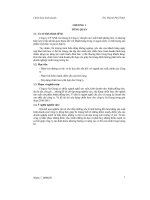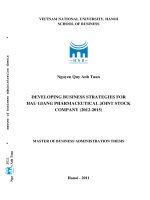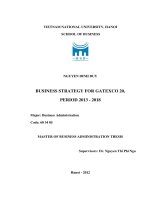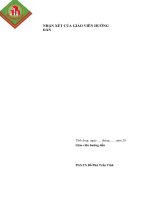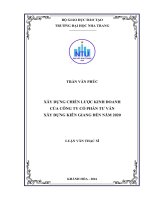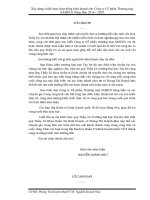Developing business strategies for Hau Giang Pharmaceutical Joint Stock Company (2012-2015)= Xây dựng chiến lược kinh doanh cho công ty cổ phần dược Hậu Giang giai đoạn 2012-2015
Bạn đang xem bản rút gọn của tài liệu. Xem và tải ngay bản đầy đủ của tài liệu tại đây (1.15 MB, 132 trang )
VIETNAM NATIONAL UNIVERSITY, HANOI
SCHOOL OF BUSINESS
Nguyen Quy Anh Tuan
DEVELOPING BUSINESS STRATEGIES FOR
HAU GIANG PHARMACEUTICAL JOINT STOCK
COMPANY (2012-2015)
MASTER OF BUSINESS ADMINISTRATION THESIS
Hanoi - 2011
2011 * master of business administration thesis
*
Nguyen Quy Anh Tuan
VIETNAM NATIONAL UNIVERSITY, HANOI
SCHOOL OF BUSINESS
Nguyen Quy Anh Tuan
DEVELOPING BUSINESS STRATEGIES FOR
HAU GIANG PHARMACEUTICAL JOINT STOCK
COMPANY (2012-2015)
Major: Business Administration
Code: 60 34 05
MASTER OF BUSINESS ADMINISTRATION THESIS
Supervisor: Dr. Vu Anh Dung
Hanoi - 2011
viii
TABLE OF CONTENTS
ACKNOWLEDGEMENTS i
ABSTRACT ii
TÓM TẮT v
TABLE OF CONTENTS viii
LIST OF TABLES xi
LIST OF FIGURES xii
LIST OF ABBREVIATIONS xiii
CHAPTER 1: INTRODUCTION 1
1.1. Necessity of the thesis 1
1.2. Research aim and objectives 3
1.3. Research questions 4
1.4. Research methodology 4
1.5. Scope of the research 5
1.6. Significance of the research 6
1.7. Suggestions for future research 7
1.8. Thesis structure 7
CHAPTER 2: LITERATURE REVIEW 9
2.1 Strategy overview 9
2.1.1 Strategy definition 9
2.1.2 Hierarchy and types of strategy 11
2.2 Strategic management process 16
2.3 External scanning: macro environment and industry
environment analysis 17
2.3.1 Macro environmental analysis: P.E.S.T.E.L Model 17
2.3.2 Industry environment analysis 18
ix
2.3.3 Synthesis of external factors – External Factors Analysis Summary
(EFAS) 23
2.4 Internal scanning: organization analysis 25
2.4.1 Resource-based view of the firm 25
2.4.2 Value chain of the firm 26
2.4.3 Synthesis of internal factors – Internal Factors Analysis Summary
(IFAS) 28
2.5 Strategy formulation 29
2.6 Strategy implementation 30
2.6.1 Management issues 30
2.6.2 Tactical issues 34
2.7 Strategy evaluation and control 35
2.8 Chapter review 37
CHAPTER 3: ANALYSIS ON VIETNAM PHARMACEUTICAL
MARKET 39
3.1. Overview of Vietnam pharmaceutical market 39
3.2. Notable characteristics of Vietnam pharmaceutical market 42
3.3. Forecasts on Vietnam pharmaceutical market in 2012 – 2015 50
3.3.1. Development prospects of Vietnam pharmaceutical market 50
3.3.2. Prescription drug market forecast 51
3.3.3. OTC drug market forecast 51
3.3.4. Patented Drug Market Forecast 52
3.3.5. Generic drug market forecast 53
3.3.6. Pharmaceutical Trade forecast 54
3.4. Synthesis of External Factors – EFAS (External Factors Analysis
Summary) 55
3.5. Chapter review 58
x
CHAPTER 4: ANALYSIS ON DHG PHARMACEUTICAL COMPANY62
4.1 Overview of DHG pharmaceutical company 62
4.1.1 Establishment and development of DHG 62
4.1.2 Scope of business and major products of DHG 64
4.1.3 Vision, mission and core values of DHG 65
4.1.4 Organizational structure of DHG 66
4.1.5 Business performance of DHG 67
4.3 Internal analysis for DHG 69
4.3.1 Value chain analysis of DHG 70
4.3.2 Distinctive competencies of DHG 75
4.4 Competitive position of DHG 77
4.5 Synthesis of internal factors – IFAS (Internal Factors Analysis
Summary) 87
4.6 Chapter review 91
CHAPTER 5: STRATEGY DEVELOPMENT FOR DHG IN 2012 – 2015 93
5.1 Orientations and objectives of DHG in 2012-2015 93
5.2 Strategy development for DHG 94
5.2.1 International experience on strategy development 94
5.2.2 TOWS Matrix of DHG 95
5.2.3 Strategy development of DHG in 2012 - 2015 97
5.3 Recommendations for implementing and controlling DHG’s
strategies 105
CONCLUSION 107
REFERENCES 109
xi
LIST OF TABLES
Table 2.1: Ten schools of strategic thought 10
Table 2.2: Types of strategy 12
Table 2.3: External Factors Analysis Summary (EFAS): Maytag Example 24
Table 2.4: Internal Factors Analysis Summary (IFAS): Maytag as Example 28
Table 2.5: TOWS Matrix 29
Table 2.6: Corporate Governance Mechanisms 33
Table 3.1: Vietnam Pharmaceutical Industry SWOT 40
Table 3.2: Revenues and Profits of listed Vietnamese Pharmaceutical
Companies in 2009 47
Table 3.3: Synthesis of External Factors – EFAS of DHG 56
Table 4.1: Milestones of DHG 63
Table 4.2: Evaluation of DHG’s Competencies 76
Table 4.3: Listed Vietnamese Pharmaceutical Companies 78
Table 4.4: Classification of listed pharmaceutical companies in Vietnam 82
Table 4.5: Weighted Competitive Strengths Assessment of DHG, Imexpharm,
Domesco, Vien Dong Pharma . 87
Table 4.6: Synthesis of Internal Factors – IFAS of DHG 88
Table 5.1: TOWS Matrix of DHG 96
xii
LIST OF FIGURES
Figure 2.1: Corporate Strategies 14
Figure 2.2: The Five Generic Competitive Strategies 15
Figure 2.3: Strategic Management Model 17
Figure 2.4: Porter’s Five Forces Model 18
Figure 2.5: Strategic Group in the Pharmaceutical Industry 22
Figure 2.6: Firm’s Value Chain 27
Figure 2.7: Why Do Control System Fail 36
Figure 3.1: Vietnam Pharmaceutical Market Share 39
Figure 3.2: Vietnam pharmaceutical market’s value and growth rate 43
Figure 3.3: Prescription Drug Market Forecast 51
Figure 3.4: OTC Medicine Market Forecast 52
Figure 3.5: Patented Drug Market Forecast 53
Figure 3.6: Generic Drug Market Forecast 53
Figure 3.7: Pharmaceutical Trade Forecast 55
Figure 4.1: DHG’s Major Products 64
Figure 4.2: Organizational Structure of DHG 66
Figure 4.3: Net Sale and Profit after Tax of DHG 67
Figure 4.4: Growth Rates of DHG 68
Figure 4.5: Profitability Ratios of DHG 69
Figure 4.6: Chain value of DHG 70
Figure 4.7: DHG Distribution System 73
xiii
LIST OF ABBREVIATIONS
BMI Business Monitor International
DAV Drug Admistration of Vietnam
DCL Cuu Long Pharma Company
DHT Ha Tay Pharma Company
DMC Domesco Pharma Company
DVD Vien Dong Pharma Company
EFAS External Factors Analysis Summary
GDP Good Distribution Practice
GLP Good Laboratory Practice
GPP Good Pharmacy Practice
GSP Good Storage Practice
GSK GlaxoSmithKline
IMP Imxepharm Company
LDP Lam Dong Pharma Company
MKP Mekopharm Company
OPC OPC Pharma Company
PMC Pharmedic Company
WHO World Health Organization
R&D Research & Developement
RBV Resource-based view of the firm
SPM SPM Pharma Company
TRA Traphaco Pharma Company
VMD Vimedimex Company
1
CHAPTER 1: INTRODUCTION
1.1. Necessity of the thesis
Vietnam's pharmaceutical industry is in a period of substantial growths.
According to the Drug Administration of Vietnam (DAV), the total value of
drugs utilized in Vietnam in 2009 was estimated to be approximately 1.7
billion dollars, an increase of 19 percent against 2008
1
. Total medication
spending per capita in 2009 reached 19.8 dollars, raising 3.3 and 13.7 dollars
with respect to the years 2008 and 2001
2
. DAV also explicitly indicated that
Vietnam pharmaceutical market would continue to grow at a rapid annual rate
of 25 percent, reaching a 2-billion-dollar value in 2012. The figure is subject
to continuous increase over the subsequent years
3
.
Being regarded as the leading company in the industry, Hau Giang
pharmaceutical (DHG) is well known for being voted in 14 consecutive years
by consumers as Vietnamese high quality product. Additionally, it ranked first
in terms of sales volume among all local pharmacies and was third in
revenues after two foreign firms in the Vietnamese market (DHG, 2009).
Delivering a speech at the summation operations ceremony in 2009, the
company's representatives emphasized that business strategy was one key
element to its success in recent years
4
.
1
“Vietnam pharmaceutical market increases 25%”. 31/5/2010. SaigonTimes Online. Retrieved from
2
Ibid.
3
Ibid.
4
“DHG’s profit: twice as high as that of the last year period”. 1/12/2009. Vneconomy. Retrieved from
2
However, challenges that DHG is facing in the coming years are likely
to be fierce, not only from competitions of strong domestic pharmaceutical
companies but also from competitions of foreign pharmaceutical companies.
Many leading multinational pharmaceutical companies have
established their representative offices and have been operating in Vietnam
since long time ago such as Pfizer (USA), Bristol Mayer Squipp (USA), Jasen
Cilag (subsidiary company of Johnson & Johnson, USA), Stada (Germany),
Bayer (Germany), Boehringer (Germany), Sanofi-Anventis (France),
GlaxoSmithKline - GSK (UK), Gedeon Richer (Hungary), Roche (Swiss),
United Pharma (Phillipines).
Many international pharmaceutical companies have begun to expand
their operations in Vietnam market through investing on building their own
factories or outsourcing domestic pharmaceutical companies to manufacture
their drugs. In November 2010, Acitivis, the fifth largest generic drug
manufacturer, held a press conference to introduce cooperation opportunity
between it and other Vietnamese pharmaceutical companies and express its
ambition to penetrate Vietnam’s drug sector through cooperation with them
5
.
In December 2010, GSK signed cooperation contract to appoint SaviPharm to
manufacture drugs for GSK in Vietnam market
6
.
Together with commitments of Vietnam to WTO, foreign
pharmaceutical companies will have the rights to open branches in Vietnam
and directly import pharmaceuticals. After 5 years since joining WTO
7
,
Vietnam will also have to reduce tax of imported pharmaceutical to 2.5%.
5
“Pharmaceutical market and moves of foreign investors”. 30/11/2010. Vneconomy. Retrieved from
/>ngoai.htm
6
“SaViPharm manufactures medicine for GlaxoSmithKline”. 16/12/2010. SaigonTimes Online. Retrieved
from />GlaxoSmithKline.html
7
“Vietnam pharmaceutical market increases 25%”, op cit. 31/5/2010. SaigonTimes Online
3
Consequently, from 2012 onwards, the challenges to Vietnamese
pharmaceutical companies in general and DHG in particular will become
fiercer and fiercer. In this context, it is absolutely vital to develop suitable
business strategies for DHG over the next period 2012-2015.
1.2. Research aim and objectives
The aim of this thesis is to propose suitable business strategies, which fit
between internal resource and external enviroments, in order to create
sustainable competitive advantage for DHG in the period of 2012-2015.
To realize this aim, the thesis recognizes the key following objectives:
1. To summarize specific characteristics of Vietnam phamarceutical
market (size, growth rate, market segment, medicine spending,
market shares of drug companies) and forecasts on future
development of the market in 2012-2015. To identify Strategic
groups and Key Success Factors of the market. To carefully evaluate
the market with P.E.S.T.E.L Model and Porter’s Five Forces Model.
To identify opportunities and threats that DHG will confront with to
construct EFAS Matrix (External Factors Analysis Summary) for
DHG.
2. To introduce and analyze business performance of DHG in recent
years in comparison with its major competitors. To carefully
analyze DHG with Value chain and Resource-based view, core
competencies. To identify strengths, weaknesses of DHG in order to
construct IFAS (Internal Factors Analysis Summary) Matrix for DHG.
3. To construct TOWS Matrix and propose suitable business strategy
for DHG to take full advantages of strengths, opportunities and
eliminate weaknesses, threats of the company in order to create
sustainable competitive advantages for DHG.
4
4. To give recommendation to implement the proposed business
strategy.
1.3. Research questions
In order to propose suitable business strategies for DHG in 2012-2015, the
thesis is going to find answers for the following research questions:
1. Major research question:
Which business strategies will be suitable for DHG in 2012-2015?
What should be done to successfully implement the proposed
strategies?
2. Minor research questions:
What are some external factors affecting DHG? What are the effects
of these factors on DHG? Opportunities and threats that DHG will
confront with in the period?
What are internal factors affecting DHG? What are the impacts of
these factors on DHG? Strengths and weaknesses that DHG will
confront with in the period?
What are the competitions in Vietnam pharmaceutical industry like
at the present and in the future? In order to succeed in the industry,
what factors should be taken into consideration?
1.4. Research methodology
There are three ways to classify research in term of perspectives (Kumar,
2005):
Application of the research (pure or applied research).
Objectives in undertaking the research (descriptive, correlation,
explanatory or exploratory research).
Inquiry mode employed (qualitative or quantitative research).
5
These classifications are not mutually exclusive since one research can be a
combination of several types of researches.
The thesis researches theory on strategy and strategic management in
order to apply them to develop business strategy for DHG in 2012-2015
(applied research). In the process of developing strategy for DHG, the thesis
describes, analyzes Vietnam pharmaceutical industry as well as DHG and its
competitors in the industry.
Case study method was utilized (in qualitative research method) in the
thesis. The case of DHG was researched in comparison with major
competitors of DHG (Vietnamese pharmaceutical companies which were
listed and produced generic drugs). Data used in the thesis were taken from
both reliable secondary data of prestigious market research (Business Monitor
International – BMI) and state agency of drugs and healthcare (Drugs
Administration of Vietnam – DAV, Ministry of Health) as well as from
audited financial reports of listed Vietnamese pharmaceutical companies.
Future forecasts of Vietnam pharmaceutical industry are extracted from
Vietnam Pharmaceuticals and Healthcare Report which was conducted by
BMI and published in the fourth quarter of 2010. Analysis used in the thesis
was gathered from the self-evaluation of the author on the current situation of
the industry, combined with knowledge generated from the interviews with
numerous experts in the field.
1.5. Scope of the research
The thesis strives to propose business strategies for DHG during the
years 2012-2015, and it involves analyzing two crucial time frames. For
instance, statistics and information gathered over the years 2007-2011 are
used to achieve better understanding of recent activities of Vietnam
pharmaceutical industry, and predictions for the subsequent years (2012-
6
2015) helps the company to determine what steps need to be taken to create
and remain its competitive advantages in the industry.
The thesis focuses on:
1. Studying macro environment and pharmaceutical industry
environment with P.E.S.T.E.L and Porter’s Five Forces Model.
Studying Strategic groups and Key Success Factors (KSF) in
Vietnam pharmaceutical industry.
2. Studying and analyzing different aspects of DHG such as: business
orientations, business result, value chain as well as operational
activities. Summarizing strengths, weaknesses of DHG.
3. Proposing suitable business strategies for DHG in 2012-2015.
Proposing activities and solutions for the implementation of its
strategies.
1.6. Significance of the research
The thesis has both theoretical and realistic significances, and it could
be useful for a number of target audience such as (1) leaders and strategy
planning managers of pharmaceutical companies, (2) researchers of strategic
management such as professors and students in university and research
institutes.
The thesis reviews theories on strategy and strategic management, and
utilizing contemporary strategies such as resource-based view of the firm,
core competencies, distinctive competencies, sustainable competitive
advantages and so on to provide readers with the most up-to-date knowledge
of strategic management.
The thesis also provide deep analyses on Vietnam pharmaceutical
industry in the period of 2012-2015, relying on trustworthy secondary source
of Drugs Administration of Vietnam - a unit under Ministry of Health, and
7
Business Monitor International - an international and prestigious market
research. Combining them with the information generated from the interviews
with experts in the industry, the thesis has also indicated Strategic Groups in
the industry and Key Success Factors of pharmaceutical companies in
Vietnam.
The thesis provides deep analyses and detailed comparison on
pharmaceutical companies who are rivals of DHG. The suggestions of
strategy and strategy implementation for DHG proposed by the thesis could
be a good source of references to pharmaceutical companies that are operating
in Vietnam.
1.7. Suggestions for future research
Future researches could focus on the following research directions: (1)
strategy adjustments of multinational drugs companies in Vietnam in
comparison with the global strategy of their parents companies, (2) strategy
development and implementation in 100-percent-state-owned drug
companies, (3) Research and development model of new medicines for
Vietnamese drug companies.
1.8. Thesis structure
The thesis has 5 chapters, namely:
Chapter 1: Introduction. This chapter gives introductory information about
the thesis including necessity of the thesis, aims and objectives of the
research, research question, research methodology, significances and scopes
of research.
Chapter 2: Literature review. This chapter reviews relevant literature of
strategy and strategic management such as internal and external environment
analysis, strategy development, strategy implementation, strategy evaluation
and control.
8
Chapter 3: Analysis on Vietnam pharmaceutical market. This chapter
describes overview of Vietnam pharmaceutical market and its notable
characteristics as well as market forecasts in 2012-2015.
Chapter 4: Analysis on DHG pharmaceutical company. This chapter
introduces the establishment and development, products, and business
performances of DHG. This chapter also gives assessments of internal and
external environment of DHG to identify and evaluate strengths, weaknesses,
opportunities, and threats of DHG.
Chapter 5: Strategy development for DHG in 2012-2015. This chapter
develops business strategies and recommendations for strategy
implementation for DHG from the year 2012 to 2015.
9
CHAPTER 2: LITERATURE REVIEW
This chapter reviews the literature of strategy and strategic
management. Firstly, various definitions and schools of thought of strategy
are summarized. Next, hierarchy and types of strategy are presented. Finally,
strategic management process and specific implementation method in the
process such as internal and external scanning, strategy formulation, strategy
implementation and strategy control, are pointed out.
2.1 Strategy overview
2.1.1 Strategy definition
Hunger and Wheelen (2000) define strategy as “a master plan stating
how the corporation will achieve its mission and objectives. It maximizes
competitive advantage and minimizes competitive disadvantage.” (p.8).
According to Thompson, Strickland and Gamble (2005), an
organization’s strategy “consists of the competitive moves and business
approaches that managers employ to attract and please customers, compete
successfully, grow the business, conduct operations, and achieve targeted
objectives” (p.3).
From above definitions, it is easily seen that strategy consists of the
following elements: (1) Objectives of the company, (2) Plans and activities of
the company, and (3) Resources and competitive position of the company.
In other words, strategy helps company to answer the following
questions?
1. Where is it current standing?
2. What is the direction for success of the company?
3. How will it get there?
10
There are many schools of thought on strategy depending on
approaches. In the book “Strategy Safari: A Guided Tour through the Wilds of
Strategic Management” published in 1998, Mintzberg, Ahlstrand, and
Lampel summarized 10 schools of thought on strategy. Main content of them
is introduced in Table 2.1.
However, strategy is not only application one school of thought, it is
the combination of many ones. Mintzberg thoughts that strategy planners
could be able to choose suitable strategy to their companies if they know the
characteristics of these schools of thought (Niven, 2002).
Table 2.1: Ten schools of strategic thought
Design School: Proposes a model of strategy making that seeks to attain a
fit between internal capabilities and external possibilities. Probably the
most influential school of thought and home of the SWOT (strengths,
weaknesses, opportunities, and threats) technique.
Planning School: Formal procedure, formal training, formal analysis, and
lots of numbers are the hallmark of this approach. The simple informal
steps of the design school become an elaborated sequence of steps. Produce
each component part as specified, assemble them according to the blueprint,
and strategy will result.
Positioning School: Suggests that only a few key strategies (positions in
the economic marketplace) are desirable. Much of Michael Porter's work
can be mapped to this school.
Entrepreneurial School: Strategy formation results from the insights of a
single leader, and stresses intuition, judgment, wisdom, experience, and
insight. The "vision" of the leader supplies the guiding principles of the
strategy.
11
Cognitive School: Strategy formation is a cognitive process that takes
place in the mind of the strategist. Strategies emerge as the strategist filters
the maps, concepts, and schemas shaping their thinking.
Learning School: Strategies emerge as people (acting individually or
collectively) come to learn about a situation as well as their organization's
capability of dealing with it
Power School: This school stresses strategy formation as an overt process
of influence, emphasizing the use of power and politics to negotiate
strategies favorable to particular interests.
Cultural School: Social interaction, based on the belief and understanding
shared by the members of an organization, lead to the development of
strategy.
Environmental School: Presenting itself to the organization as a set of
general forces, the environment is the central actor in the strategy making
process. The organization must respond to the factors or be "selected out".
Configuration School: Strategies arise from periods when an organization
adopts a structure to match to a particular context that give rise to certain
behaviors.
Source: Niven (2002, p. 91).
2.1.2 Hierarchy and types of strategy
There are many ways to classify strategies (see Table 2.1). When a
company changes its purpose, operating area, competitive position in
industry, its strategy will be changed accordingly.
12
Table 2.2: Types of strategy
Order
Criteria Strategy types
1.
Strategy level
Corporate strategy
Business/competitive strategy
Functional strategy
2.
Purpose of strategy
Offensive strategy
Defensive strategy
Cooperative strategy
Competitive strategy
3.
Operating area
Domestic strategy
International strategy
Global strategy
4.
Competitive position
of the company
Leader’s strategy
Challenger’s strategy
Follower’s strategy
5.
Development stage of
the company
Growth strategy
Stability strategy
Rechenment strategy
6.
Stage of the industry
Strategy in emerging industry
Strategy in high-velocity market
Strategy s in maturing industry
Strategy in stagnant or declining industry
Source: Adapted from Hunger et al. (2000), Hitt et al. (1999), Thompson et
al. (1998), Porter (1980).
13
Business strategies are often classified according to different levels of a
company’s structure. Hunger et al. (2000), Hitt et al. (1999), and Thompson
et al. (1998) have reached a consensus that a diversified corporation has three
levels of strategy: (1) corporate strategy, (2) business strategy, and (3)
functional strategy.
Corporate strategy is the overall strategy of the whole corporation,
answering the questions “What kinds of business should the corporation
participate in?” and "How should the corporation build the synergy of each
individual company as a whole?" Business strategy or competitive strategy is
strategy for strategic business unit of the corporation, answering the question
“How should the company compete in the industry?” Functional strategy is
strategy of specialized departments which implement business and corporate
strategy.
According to Hunger et al. (2000), in corporate strategy, there are
groups of strategies that are kept in accordance with the development stage of
the company such as growth strategies, stability strategies, and rechenment
strategies (See Figure 2.1.). Growth strategy is used when the corporation
wants to grow. It can grow by concentration strategy or diversification
strategy. Stability strategy is used when the corporation wants to grow slowly.
Rechenment strategy is used when the corporation is in difficult time.
14
Figure 2.1: Corporate Strategies
Growth
Concentration
Vertical Integration
Horizontal Integration
Diversification
Concentric
Conglomerate
Stability
Pause
Proceed with Caution
No Change
Profit
Rechenment
Turnaround
Captive Company
Selling Out/Divestiture
Bankruptcy
Liquidation
Source: Hunger et al. (2000, p. 82)
In business strategy level, there are 3 generic strategies suggested by M.
Porter in his book Competitive strategies (1980): (1) Cost leadership strategy
(2) Differentiation strategy (3) Focus strategy.
Criteria to classify 3 generic strategies are (1) price of the product, (2)
differentiation of the product, and (3) market range.
In a broad market range, competitive strategy will have 2 generic
strategies: (1) Cost leadership strategy, and (2) Differentiation strategy. A
company which follows cost leadership strategy will produce cheaper
products than its competitors’ ones. A company following differentiation
strategy will provide unique products, which allows it to sell them in higher
15
price to its competitors. In a narrow market range, focus strategies are cost
leadership strategy and differentiation strategy (focused cost leadership
strategy or focused differentiation strategy).
Thompson and Strickland (2005) proposed Best-cost provider strategy in
business/competitive strategy. It is the combination of low-cost provider
strategy and differentiation strategy in both broad market and narrow market.
Figure 2.2 summaries five generic competitive strategies.
Figure 2.2: The Five Generic Competitive Strategies
Source: Thompson et al. (2005, p. 116)
Functional strategies (e.g. marketing strategy, HR strategy, finance
strategy, operation strategy…) are strategies that support corporate strategy
and business strategy.
16
In this thesis, corporate strategies and competitive strategies, proposed
by Hunger et al. (2000) and Thompson et al. (2005) and illustrated in Figure
2.1 and Figure 2.3, are used to analyze and develop strategy for DHG.
2.2 Strategic management process
According to Gluck, Kaufman, and Waleck, the development history of
strategic management are as follows (Hunger et al., 2000, p.3):
Phase 1. Basic financial planning: seeking better operational control
by trying to meet budgets.
Phase 2. Forecast-based planning: seeking more effective planning
for growth by trying to predict the future beyond the next year.
Phase 3. Externally oriented planning (strategic planning): seeking
increased responsiveness to markets and competition by trying to think
strategically.
Phase 4. Strategic management: seeking a competitive advantage and
successful future by managing all resources effectively.
Besides the planning as in phase 3, implementation, evaluation and control
phases should also be taken into consideration.
Strategic management is the process of consecutive steps. According to
Hitt et al. (1999), strategic management process as a process of two major
groups of activities:
1. Identifying strategic inputs: the first step is conducting internal and
external analyses, then identifying the strategic intent and strategic
mission of the company.
2. Implementing strategic actions: includes strategy formulation and
strategy implementation.
Similarly, Thompson (2005) proposed 5 steps in crafting and executing a
company’s strategy: (1) develop strategic vision, (2) establish objectives, (3)
17
develop strategies to realize vision and objectives, (4) implement strategies,
and (5) measure, evaluation and adjust strategies when needed.
Byars, Rue and Zaira (1996) divided strategic management process into
4 steps: (1) Environmental scanning (2) strategy formulation, (3) strategy
implementation, and (4) strategy evaluation and control. (See Figure 2.3)
Figure 2.3: Strategic Management Model
Source: Byars et al. (1996, p.6)
In this thesis, strategic management process model proposed by Byars
et al. (1996) (see Figure 2.3) is used because of its generality.
2.3 External scanning: macro environment and industry environment
analysis
2.3.1 Macro environmental analysis: P.E.S.T.E.L Model
Macro environment consists of factors that are out of control of the
companies in short term, and have impacts on an industry and companies
within the industry (Byar et al., 1996). Understanding the factors of macro
environment will help company to develop suitable strategies.
P.E.S.T.E.L Model indicates major factors of macro environment
which the company need to pay close attention to: (1) Political force, (2)


